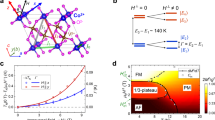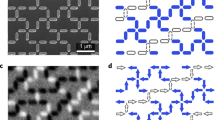Abstract
Frustration, defined as a competition between interactions such that not all of them can be satisfied, is important in systems ranging from neural networks to structural glasses. Geometrical frustration, which arises from the topology of a well-ordered structure rather than from disorder, has recently become a topic of considerable interest1. In particular, geometrical frustration among spins in magnetic materials can lead to exotic low-temperature states2, including ‘spin ice’, in which the local moments mimic the frustration of hydrogen ion positions in frozen water3,4,5,6. Here we report an artificial geometrically frustrated magnet based on an array of lithographically fabricated single-domain ferromagnetic islands. The islands are arranged such that the dipole interactions create a two-dimensional analogue to spin ice. Images of the magnetic moments of individual elements in this correlated system allow us to study the local accommodation of frustration. We see both ice-like short-range correlations and an absence of long-range correlations, behaviour which is strikingly similar to the low-temperature state of spin ice. These results demonstrate that artificial frustrated magnets can provide an uncharted arena in which the physics of frustration can be directly visualized.
This is a preview of subscription content, access via your institution
Access options
Subscribe to this journal
Receive 51 print issues and online access
$199.00 per year
only $3.90 per issue
Buy this article
- Purchase on Springer Link
- Instant access to full article PDF
Prices may be subject to local taxes which are calculated during checkout



Similar content being viewed by others
References
Ramirez, A. P. in Handbook of Magnetic Materials Vol. 13 (ed. Buschow, K. J. H.) 423–520 (Elsevier Science, Amsterdam, 2001)
Moessner, R. Magnets with strong geometric frustration. Can. J. Phys. 79, 1283–1294 (2001)
Harris, M. J., Bramwell, S. T., McMorrow, D. F., Zeiske, T. & Godfrey, K. W. Geometrical frustration in the ferromagnetic pyrochlore Ho2Ti2O7 . Phys. Rev. Lett. 79, 2554–2557 (1997)
Siddharthan, R. et al. Ising pyrochlore magnets: low-temperature properties, “ice rules,” and beyond. Phys. Rev. Lett. 83, 1854–1857 (1999)
Ramirez, A. P., Hayashi, A., Cava, R. J., Siddharthan, R. & Shastry, B. S. Zero-point entropy in ‘spin ice’. Nature 399, 333–335 (1999)
Bramwell, S. T. & Gingras, M. J. P. Spin ice state in frustrated magnetic pyrochlore materials. Science 294, 1495–1501 (2001)
Pauling, L. The Nature of the Chemical Bond 301–304 (Cornell Univ. Press, Ithaca, New York, 1945)
Snyder, J., Slusky, J. S., Cava, R. J. & Schiffer, P. How ‘spin ice’ freezes. Nature 413, 48–51 (2001)
Snyder, J. et al. Low-temperature spin freezing in the Dy2Ti2O7 spin ice. Phys. Rev. B 69, 064414 (2004)
Tsui, Y. K., Burns, C. A., Snyder, J. & Schiffer, P. Magnetic field induced transitions from spin glass to liquid to long range order in a 3D geometrically frustrated magnet. Phys. Rev. Lett. 82, 3532–3535 (1999)
Gardner, J. S. et al. Cooperative paramagnetism in the geometrically frustrated pyrochlore antiferromagnet Tb2Ti2O7 . Phys. Rev. Lett. 82, 1012–1015 (1999)
Davidovic, D. et al. Correlations and disorder in arrays of magnetically coupled superconducting rings. Phys. Rev. Lett. 76, 815–818 (1996)
Hilgenkamp, H. et al. Ordering and manipulation of the magnetic moments in large-scale superconducting π-loop arrays. Nature 422, 50–53 (2003)
Cowburn, R. P. & Welland, M. E. Room temperature magnetic quantum cellular automata. Science 287, 1466–1468 (2000)
Ross, C. A. et al. Magnetic behaviour of lithographically patterned particle arrays (invited). J. Appl. Phys. 91, 6848–6853 (2002)
Cowburn, R. P. Probing antiferromagnetic coupling between nanomagnets. Phys. Rev. B 65, 092409 (2002)
Martin, J. I., Nogues, J., Liu, K., Vicent, J. L. & Schuller, I. K. Ordered magnetic nanostructures: fabrication and properties. J. Magn. Magn. Mater. 256, 449–501 (2003)
Imrea, A., Csabaa, G., Bernstein, G. H., Porod, W. & Metlushko, V. Investigation of shape-dependent switching of coupled nanomagnets. Superlatt. Microstruct. 34, 513–518 (2003)
Stamps, R. L. & Camley, R. E. Frustration and finite size effects of magnetic dot arrays. J. Magn. Magn. Mater. 177, 813–814 (1998)
The Object Oriented MicroMagnetic Framework (OOMMF) project at ITL/NIST. http://math.nist.gov/oommf/ (2005).
Lieb, E. H. & Wu, F. Y. in Phase Transitions and Critical Phenomena (eds Domb, C. & Green, M. S.) Vol. I (Academic, London, 1972)
Melko, R. G., den Hertog, B. C. & Gingras, M. J. P. Long-range order at low temperatures in dipolar spin ice. Phys. Rev. Lett. 87, 067203 (2001)
Zhitomirsky, M. E., Honecker, A. & Petrenko, O. A. Field induced ordering in highly frustrated antiferromagnets. Phys. Rev. Lett. 85, 3269–3272 (2001)
Yang, X. M. et al. Fabrication of sub-50 nm critical feature for magnetic recording device using electron-beam lithography. J. Vac. Sci. Technol. B 21, 3017–3020 (2003)
Lin, C. K., Wang, W., Hwu, H. & Chan, Y. Single step electron-beam lithography for asymmetric recess and gamma gate in high electron mobility transistor fabrication. J. Vac. Sci. Technol. B. 22, 1723–1726 (2004)
Acknowledgements
We acknowledge financial support from the Army Research Office and the National Science Foundation MRSEC programme, and discussions with P. Crowell and P. Lammert. R.S.F. thanks the CNPq-Brazil for sponsorship.
Author information
Authors and Affiliations
Corresponding author
Ethics declarations
Competing interests
Reprints and permissions information is available at npg.nature.com/reprintsandpermissions. The authors declare no competing financial interests.
Rights and permissions
About this article
Cite this article
Wang, R., Nisoli, C., Freitas, R. et al. Artificial ‘spin ice’ in a geometrically frustrated lattice of nanoscale ferromagnetic islands. Nature 439, 303–306 (2006). https://doi.org/10.1038/nature04447
Received:
Accepted:
Issue Date:
DOI: https://doi.org/10.1038/nature04447
This article is cited by
-
Clocked dynamics in artificial spin ice
Nature Communications (2024)
-
Geometrical control of topological charge transfer in Shakti-Cairo colloidal ice
Communications Physics (2023)
-
Real-space observation of ergodicity transitions in artificial spin ice
Nature Communications (2023)
-
Electrically programmable magnetic coupling in an Ising network exploiting solid-state ionic gating
Nature Communications (2023)
-
Spin dynamics, loop formation and cooperative reversal in artificial quasicrystals with tailored exchange coupling
Communications Physics (2023)
Comments
By submitting a comment you agree to abide by our Terms and Community Guidelines. If you find something abusive or that does not comply with our terms or guidelines please flag it as inappropriate.



